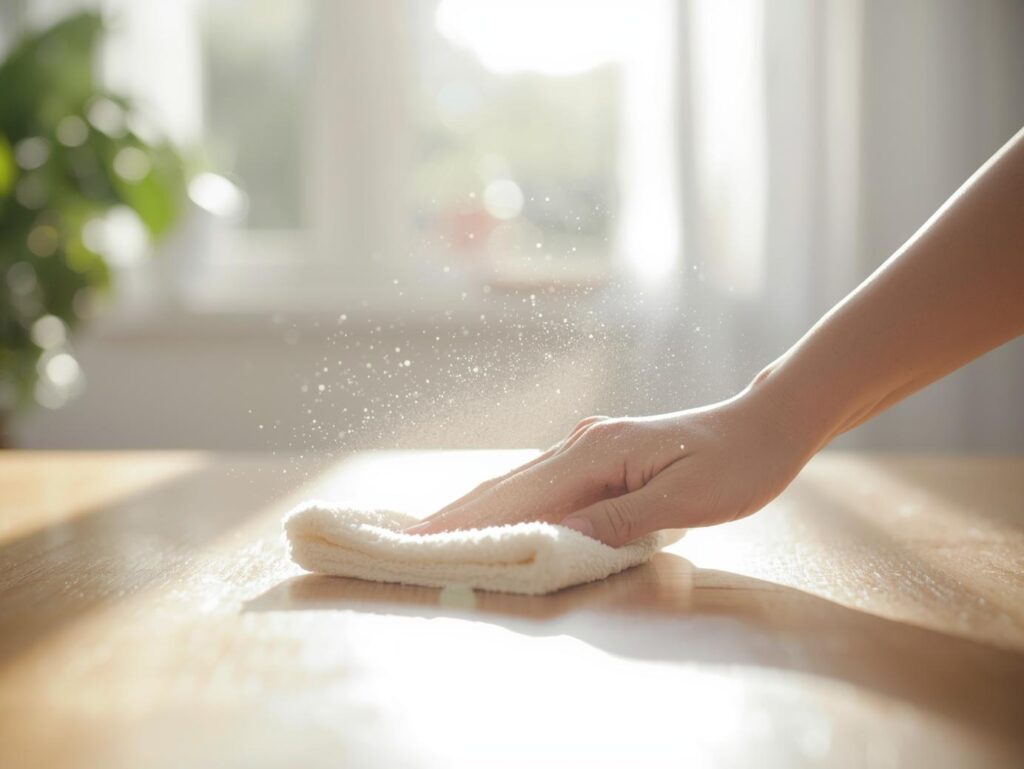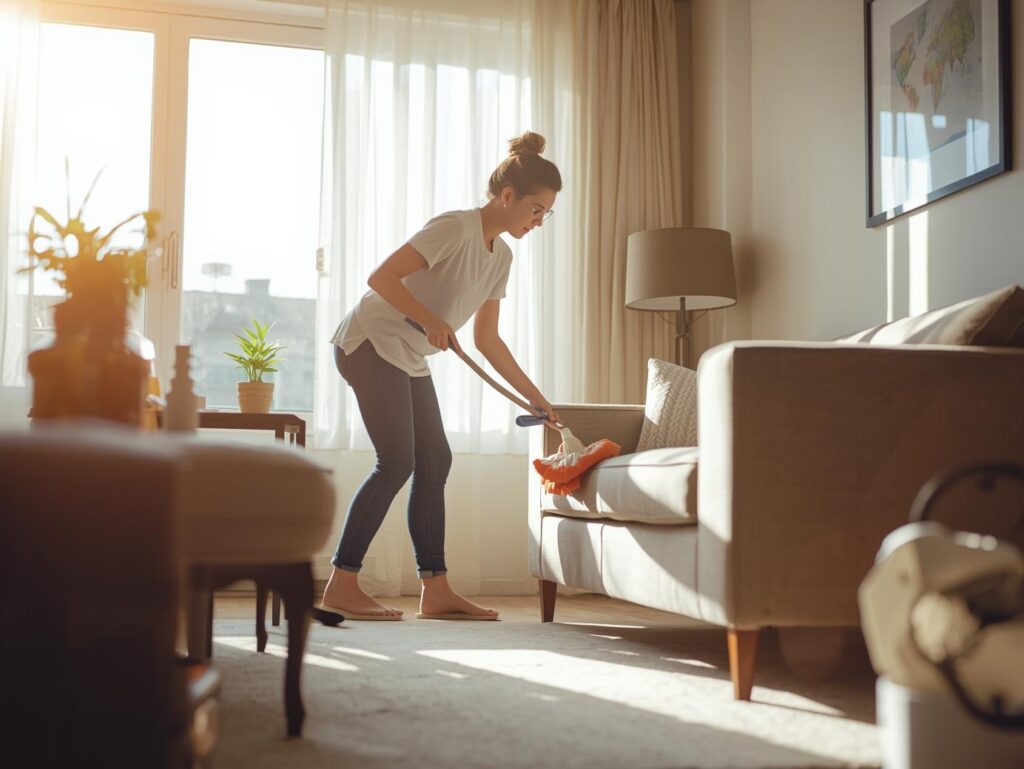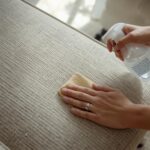Dust is one of those things that sneaks up on everyone.
One day, the house looks spotless, and the next, there’s a fine layer of gray fluff on every surface.
Dust is not just unsightly; it can trigger allergies, make your home feel less fresh, and even damage electronics and furniture over time.
The good news is that with the right approach, dusting doesn’t have to be a never-ending battle.
This short, detailed blog post is packed with practical dusting tips, clever hacks, and helpful tables to make your home cleaner and your air fresher.
What Is Dust and Why Does It Matter?

Dust is a mix of tiny particles that settle on surfaces.
It’s made up of dead skin cells, fabric fibers, pollen, pet dander, dirt, and even microscopic bits of plastic.
In some homes, dust can also include mold spores, insect debris, and soot from candles or fireplaces.
|
Component |
Source |
Potential Issues |
|---|---|---|
|
Dead skin cells |
People and pets |
Allergies, dust mites |
|
Fabric fibers |
Clothing, upholstery, carpets |
Builds up quickly |
|
Pollen |
Open windows, shoes |
Allergy trigger |
|
Pet dander |
Cats, dogs, other animals |
Asthma, allergies |
|
Dirt |
Shoes, open doors |
Gritty residue |
|
Mold spores |
Damp areas |
Respiratory issues |
|
Soot |
Candles, fireplaces |
Black stains, air quality |
Dust isn’t just a cosmetic problem.
It can affect indoor air quality, aggravate allergies, and even shorten the lifespan of electronics by clogging vents and fans.
Why Regular Dusting Matters
- Improves air quality: Less dust means fewer allergens floating around.
- Protects furniture: Dust can scratch and dull surfaces over time.
- Keeps electronics running: Dust-free vents mean cooler, longer-lasting devices.
- Makes cleaning easier: Regular dusting prevents buildup that’s harder to remove later.
- Creates a fresher, more inviting home: Nothing beats the look and feel of a freshly dusted room.
Essential Dusting Tools
Having the right tools makes dusting faster and more effective. Here’s a quick comparison:
|
Tool |
Best For |
Pros |
Cons |
|---|---|---|---|
|
Microfiber cloth |
Most surfaces |
Traps dust, reusable |
Needs washing |
|
Feather duster |
Delicate items, quick touch-ups |
Gentle, flexible |
Can spread dust |
|
Electrostatic duster |
Blinds, electronics |
Attracts dust, reusable |
May need recharging |
|
Vacuum with brush |
Floors, upholstery, vents |
Removes dust, less airborne |
Bulky |
|
Dusting mitt |
Baseboards, railings |
Fits hand, easy to use |
Limited reach |
|
Compressed air |
Keyboards, electronics |
Gets into crevices |
Can blow dust around |
|
Old t-shirt |
General dusting |
Cheap, soft |
Not as effective as microfiber |

How Often Should You Dust?
Not every surface needs dusting every day. Here’s a handy schedule:
|
Area |
Frequency |
|---|---|
|
High-traffic surfaces (tables, shelves) |
Weekly |
|
Electronics (TVs, computers) |
Weekly |
|
Floors, baseboards |
Weekly |
|
Ceiling fans, light fixtures |
Monthly |
|
Blinds, curtains |
Monthly |
|
Air vents, registers |
Monthly |
|
Behind/under furniture |
Every 2–3 months |
|
Walls, ceilings |
Every 3–6 months |
The Right Way to Dust: Step-by-Step
1. Start High, Finish Low
Dust falls as you clean, so always start with the highest surfaces (ceiling fans, shelves) and work your way down to the floors.
2. Use the Right Tool for the Job
- Microfiber cloths are best for most surfaces.
- Use a vacuum with a brush attachment for upholstery and vents.
- Feather dusters are great for delicate items but follow up with a damp cloth to catch what’s left behind.
3. Dust in One Direction
Wipe in straight lines rather than circles to avoid just moving dust around.
4. Don’t Forget Hidden Spots
- Tops of doors and picture frames
- Light switches and outlet covers
- Behind and under furniture
- Window sills and tracks
5. Finish with the Floors
Vacuum or mop floors last to pick up any dust that’s settled.
Dusting Different Surfaces
|
Surface |
Best Tool |
Tips |
|---|---|---|
|
Wood furniture |
Microfiber cloth |
Dust with the grain, polish occasionally |
|
Glass |
Microfiber + glass cleaner |
Wipe dry to avoid streaks |
|
Electronics |
Electrostatic duster, compressed air |
Unplug first, avoid moisture |
|
Blinds |
Electrostatic duster, vacuum |
Close slats, dust both sides |
|
Baseboards |
Dusting mitt, vacuum |
Work in sections |
|
Ceiling fans |
Long-handled duster |
Cover blades with pillowcase to trap dust |
|
Plants (real or fake) |
Soft brush, damp cloth |
Rinse fake plants in shower |
Natural Dusting Solutions
Skip the chemical sprays, natural solutions work just as well and are safer for your home.
DIY Dusting Spray
- 1 cup water
- 1/4 cup white vinegar
- 2 teaspoons olive oil
- 10 drops essential oil (lemon or lavender)
Mix in a spray bottle. Lightly mist your cloth (never spray directly on electronics or wood).
Anti-Static Spray for Electronics
- 1 cup distilled water
- 1 tablespoon fabric softener
Mix and lightly mist a microfiber cloth before wiping screens and keyboards.
Dusting Hacks for Hard-to-Reach Places
- Ceiling fans: Slip a pillowcase over each blade, then pull it off to trap dust.
- Blinds: Use tongs wrapped in microfiber cloths to clean both sides at once.
- Vents: Use a foam paintbrush or vacuum brush attachment.
- Baseboards: Run a dryer sheet along baseboards to repel dust.
- Behind radiators: Use a long-handled duster or blow dust out with a hairdryer (on cool).
Preventing Dust Buildup
|
Tip |
How It Helps |
|---|---|
|
Use doormats |
Traps dirt before it enters |
|
Take off shoes indoors |
Reduces tracked-in dust |
|
Change HVAC filters regularly |
Catches airborne dust |
|
Keep windows closed on windy days |
Blocks pollen and dirt |
|
Declutter surfaces |
Less to dust, fewer dust traps |
|
Wash bedding weekly |
Removes skin cells and fibers |
|
Groom pets regularly |
Reduces dander and fur |

Dusting for Allergy Sufferers
If allergies are a concern, dusting is even more important. Here’s how to make it safer:
- Wear a mask while dusting.
- Use a damp cloth to trap dust instead of sending it airborne.
- Vacuum with a HEPA filter.
- Wash hands and face after cleaning.
- Avoid feather dusters, which can stir up allergens.
Dusting Electronics and Screens
Electronics attract dust like magnets. Here’s how to keep them clean:
|
Device |
Best Method |
Extra Tips |
|---|---|---|
|
TV screens |
Dry microfiber cloth |
Never use paper towels |
|
Keyboards |
Compressed air, soft brush |
Turn upside down and tap gently |
|
Speakers |
Vacuum brush |
Avoid moisture |
|
Game consoles |
Electrostatic duster |
Keep vents clear |
Dusting Curtains, Upholstery, and Rugs
- Curtains: Wash or vacuum monthly. For quick touch-ups, use a lint roller.
- Upholstery: Vacuum with an upholstery attachment weekly.
- Rugs: Shake out small rugs outside and vacuum larger ones regularly.
Dusting Greenery: Real and Fake Plants
- Real plants: Wipe leaves with a damp cloth or rinse in the shower.
- Fake plants: Dust with a soft brush or use a hairdryer on cool.
Dusting Light Fixtures and Chandeliers
- Turn off the light and let bulbs cool.
- Use a microfiber cloth or a soft brush.
- For glass shades, remove and wash in warm, soapy water.
Dusting Walls and Ceilings
- Use a long-handled duster or a microfiber mop.
- Pay attention to corners where cobwebs collect.
- For stubborn marks, use a damp sponge with a little dish soap.
Dusting Air Vents and Registers
- Remove vent covers and wash in soapy water.
- Vacuum inside the duct as far as possible.
- Replace filters regularly.
Dusting Tips for Pet Owners
Pets add love and a lot of fur and dander. Here’s how to keep up:
|
Tip |
Benefit |
|---|---|
|
Brush pets regularly |
Less fur on surfaces |
|
Use washable slipcovers |
Easy to clean |
|
Vacuum with pet hair attachment |
Removes fur from upholstery |
|
Keep pet beds clean |
Reduces dander |
Dusting Mistakes to Avoid
|
Mistake |
Why It’s a Problem |
Better Way |
|---|---|---|
|
Dry dusting only |
Sends dust into the air |
Use a damp cloth |
|
Using the wrong cloth |
Paper towels leave lint |
Use microfiber |
|
Ignoring air vents |
Dust recirculates |
Clean vents monthly |
|
Dusting after vacuuming |
Dust settles on clean floors |
Dust first, then vacuum |
|
Overloading shelves |
More stuff = more dust |
Declutter regularly |
Creating a Dusting Routine
A regular routine makes dusting less overwhelming. Here’s a sample weekly plan:
|
Day |
Task |
|---|---|
|
Monday |
Dust living room surfaces and electronics |
|
Tuesday |
Dust bedrooms and change bedding |
|
Wednesday |
Dust kitchen surfaces and appliances |
|
Thursday |
Dust bathrooms and laundry area |
|
Friday |
Dust baseboards and doors |
|
Saturday |
Dust blinds, curtains, and light fixtures |
|
Sunday |
Rest or catch up on missed spots |
Quick Dusting Tips for Busy Days
- Use a microfiber mitt for a fast swipe of surfaces.
- Keep a small duster in each room for quick touch-ups.
- Dust one room a day instead of the whole house at once.
- Focus on high-traffic areas if you’re short on time.
Dusting and Air Quality
Dust isn’t just a surface problem it affects the air you breathe. Here’s how to keep indoor air cleaner:
- Use an air purifier with a HEPA filter.
- Keep humidity between 40–50% to reduce dust mites.
- Open windows for ventilation (when pollen counts are low).
- Avoid burning candles or using wood fireplaces frequently.
Fun Facts About Dust
- The average home collects about 40 pounds of dust per year.
- Most household dust comes from outside.
- Dust mites, which feed on dead skin cells, are a major cause of indoor allergies.
- The Sahara Desert is a huge source of dust that travels across the globe.
Frequently Asked Questions
How can I dust without spreading dust everywhere?
Use a damp microfiber cloth or an electrostatic duster. Avoid dry feather dusters, which just move dust around.
What’s the best way to dust blinds?
Close the blinds, dust one side with a microfiber cloth or duster, then reverse and do the other side. For deep cleaning, remove and wash them.
How do I keep dust off electronics?
Wipe regularly with a microfiber cloth, keep electronics off the floor, and use anti-static spray.
Is it better to dust or vacuum first?
Always dust first, then vacuum. This way, any dust that falls to the floor gets picked up.
Dusting Do’s and Don’ts
|
Do |
Don’t |
|---|---|
|
Use microfiber cloths |
Use dry paper towels |
|
Dust top to bottom |
Start with the floors |
|
Clean air vents |
Ignore hidden spots |
|
Declutter surfaces |
Let clutter collect dust |
|
Wash dusting tools regularly |
Reuse dirty cloths |
Final Thoughts
Dusting might not be the most glamorous chore, but it’s one of the most important for a clean, healthy home.
With the right tools, a smart routine, and a few clever hacks, you can keep dust under control and enjoy a fresher, more comfortable space.
Remember to dust high to low, use microfiber cloths, and don’t forget those hidden spots.
A little effort goes a long way toward a cleaner, healthier home.










